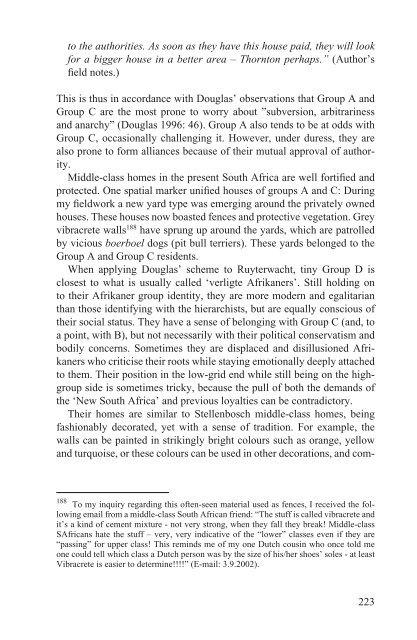The Making of a Good White - E-thesis - Helsinki.fi
The Making of a Good White - E-thesis - Helsinki.fi
The Making of a Good White - E-thesis - Helsinki.fi
You also want an ePaper? Increase the reach of your titles
YUMPU automatically turns print PDFs into web optimized ePapers that Google loves.
to the authorities. As soon as they have this house paid, they will look<br />
for a bigger house in a better area – Thornton perhaps.” (Author’s<br />
<strong>fi</strong>eld notes.)<br />
This is thus in accordance with Douglas’ observations that Group A and<br />
Group C are the most prone to worry about ”subversion, arbitrariness<br />
and anarchy” (Douglas 1996: 46). Group A also tends to be at odds with<br />
Group C, occasionally challenging it. However, under duress, they are<br />
also prone to form alliances because <strong>of</strong> their mutual approval <strong>of</strong> authority.<br />
Middle-class homes in the present South Africa are well forti<strong>fi</strong>ed and<br />
protected. One spatial marker uni<strong>fi</strong>ed houses <strong>of</strong> groups A and C: During<br />
my <strong>fi</strong>eldwork a new yard type was emerging around the privately owned<br />
houses. <strong>The</strong>se houses now boasted fences and protective vegetation. Grey<br />
vibracrete walls 188 have sprung up around the yards, which are patrolled<br />
by vicious boerboel dogs (pit bull terriers). <strong>The</strong>se yards belonged to the<br />
Group A and Group C residents.<br />
When applying Douglas’ scheme to Ruyterwacht, tiny Group D is<br />
closest to what is usually called ‘verligte Afrikaners’. Still holding on<br />
to their Afrikaner group identity, they are more modern and egalitarian<br />
than those identifying with the hierarchists, but are equally conscious <strong>of</strong><br />
their social status. <strong>The</strong>y have a sense <strong>of</strong> belonging with Group C (and, to<br />
a point, with B), but not necessarily with their political conservatism and<br />
bodily concerns. Sometimes they are displaced and disillusioned Afrikaners<br />
who criticise their roots while staying emotionally deeply attached<br />
to them. <strong>The</strong>ir position in the low-grid end while still being on the highgroup<br />
side is sometimes tricky, because the pull <strong>of</strong> both the demands <strong>of</strong><br />
the ‘New South Africa’ and previous loyalties can be contradictory.<br />
<strong>The</strong>ir homes are similar to Stellenbosch middle-class homes, being<br />
fashionably decorated, yet with a sense <strong>of</strong> tradition. For example, the<br />
walls can be painted in strikingly bright colours such as orange, yellow<br />
and turquoise, or these colours can be used in other decorations, and com-<br />
188 To my inquiry regarding this <strong>of</strong>ten-seen material used as fences, I received the following<br />
email from a middle-class South African friend: “<strong>The</strong> stuff is called vibracrete and<br />
it’s a kind <strong>of</strong> cement mixture - not very strong, when they fall they break! Middle-class<br />
SAfricans hate the stuff – very, very indicative <strong>of</strong> the “lower” classes even if they are<br />
“passing” for upper class! This reminds me <strong>of</strong> my one Dutch cousin who once told me<br />
one could tell which class a Dutch person was by the size <strong>of</strong> his/her shoes’ soles - at least<br />
Vibracrete is easier to determine!!!!” (E-mail: 3.9.2002).<br />
223
















